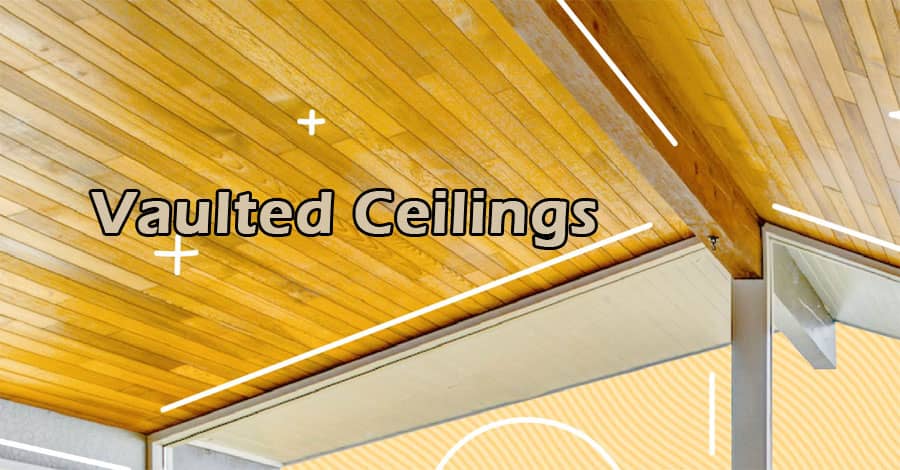Vaulted ceilings: everything you need to know

What is the actual meaning of Vaulted Ceilings?
The vaulted ceiling is a ceiling that is angled upwards towards the roof, reaching higher than a flat ceiling's average height of eight to ten feet. Since vault ceilings allow for more light and can be incorporated into any design, vault ceilings are a popular choice for contemporary architecture.
Varieties of Vaulted Ceilings
In this section, we provide you with 10 different types of vault ceiling designs you may want to consider for your next project.
Barrel Vault Ceiling
Vaulted barrel ceilings have a fairly plain appearance; they consist of simply one arch that runs the length of the space.
You may either leave the space as-is for a simple, elegant look or decorate it in a sophisticated way to make it appear more beautiful overall.
Hallways benefit greatly from barrel vaults because they provide the sense that one is in a tunnel. They also look fantastic in media rooms and foyers.
Pitched Brick Vault Ceiling
An old-style appearance is created by the pitched brick vault ceiling, giving your ceiling a more urban feel. When bricks are placed vertically, leaning to an angle, pitched brick vaults free themselves from relying on the centre to complete. Basically, the bricks are tilted.
Dome Vaulted Ceiling
Submerging a dome into a flat ceiling is a popular method of creating a domed ceiling. There is usually only a small part of the ceiling covered by them. The more you try to increase the size of a dome ceiling, the more difficult it becomes to build.
To achieve a dramatic appearance without increasing the dome's size, crown moulding can be used to accent the vaulted ceiling. Bedrooms should not be fitted with these types of flooring, but entryways or hallways can benefit from them.
Groin Vaulted Ceiling
The two-barrel type vaults with the same width and length are interlocked to create the groin-vault ceilings. Although they are simple to see in your imagination, these kinds of vault ceilings are more difficult to achieve during construction.
The borders that separate two intersecting vaults are referred to as the groyne. Sometimes the groin-shaped vaults' arches are pointed rather than circular.
Cloister Vaulted Ceiling
There are several distinct spring lines and spring locations in the cloister vault ceiling. At certain locations, the arch, in this case, one on a wall, starts to curve, each arching in the same direction. This gives the impression of being a vault for cloisters.
Cove Vaulted Ceiling
If you want a ceiling that wraps around a corner, this style of vault ceiling is ideal. The cove-style ceiling may give your room a sophisticated, modern appearance with softened edges and corners.
Igloo Vaulted Ceiling
Igloo vault ceilings, also known as lunette vault ceilings, are just barrel-vault ceilings that have had arches carved out of them. Under these arches, windows and other objects can be placed without obstructing the ceiling.
Grome Vaulted Ceiling
This ceiling combines the dome and the groin-vault ceilings, two separate types of vault ceilings. This ceiling may give your room a captivating and distinctive appearance.
Rib Vaulted Ceiling
This style of vault ceiling resembles a groin-vault ceiling, but it is built with a succession of arched-shaped strips, diagonal ribs, and stripes. This guarantees the strength and adaptability of the structure.
Fan Vaulted Ceiling
Similar to rib ceilings, fan vault ceilings are made of smaller ribs spaced evenly apart to give the impression of a fan. The beam is supported along the whole length of fan-vault ceilings.
Merits of having a Vaulted Ceilings
- In addition to giving a more architectural look to smaller rooms, vaulted ceilings create the illusion of larger rooms.
- It is possible to save energy and build green by using vault ceilings as they provide maximum natural light.
- Adding a touch of elegance to the open spaces, it adds a lavish look.
- Create vault ceilings to take advantage of dead space/open spaces in the ceiling.
- Almost any interior design style can be incorporated into this ceiling.
- The area of high temperatures and air rises can contribute to the generation of cool air.
- There is no better source of ventilation than vaulted ceilings.
Demerits of having a Vaulted Ceilings
- In addition to being expensive to maintain, vaulted ceilings are very costly to repair.
- Because these ceilings are too high and difficult to reach, they are not suitable for lighting fixtures, fans, and other decorative parts.
- For structural stability, ribs, arch supports, or roofing construction are required.
- The task of cleaning and repainting vaulted ceilings is very challenging.
- A remodelling project is not recommended for these ceilings.
